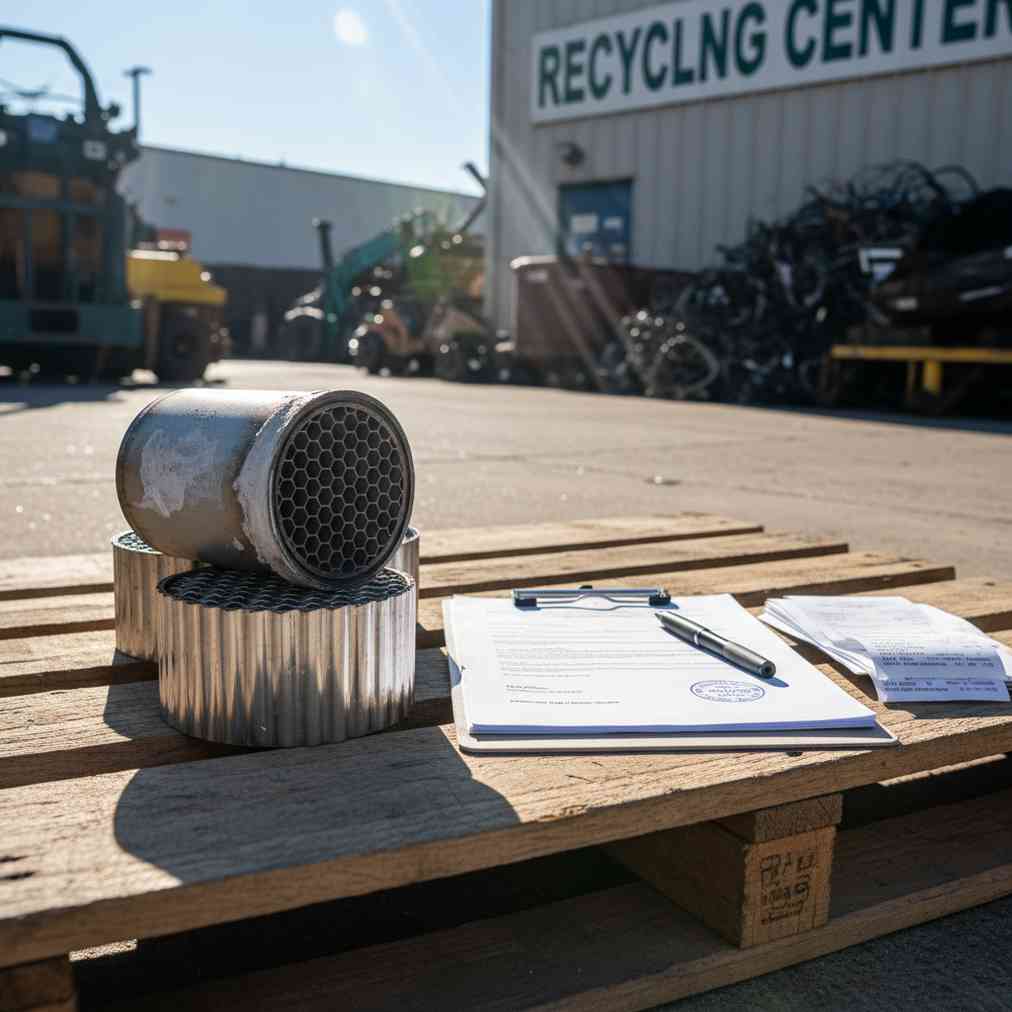Understanding the Legal Requirements for Selling Catalytic Converter Cores
The legal removal and sale of catalytic converter cores has become increasingly regulated due to rising theft rates across the United States. Before attempting to sell any catalytic converter, it’s crucial to understand the comprehensive documentation requirements and legal processes involved in legitimate transactions with recycling centers.
Essential Documentation for Legal Sales
When selling catalytic converter cores to certified recycling facilities, proper documentation serves as the foundation for legal compliance and theft prevention. The documentation requirements vary by state but generally include several key components.
- Proof of Ownership: Valid vehicle title, registration, or mechanic’s receipt showing converter replacement
- Government-issued Photo ID: Driver’s license or passport for seller verification
- Vehicle Information: Year, make, model, and VIN of the source vehicle
- Transaction Records: Signed statements and bills of sale as required by state law
- Fingerprint/Thumbprint: Some states mandate biometric identification for high-value transactions
“Catalytic converter recycling must comply with legal requirements and regulations. This includes adhering to environmental regulations regarding the proper handling, transportation, and processing of used converters.”
State-Specific Legal Requirements
| State | Key Requirements | Additional Notes |
|---|---|---|
| California | State ID, ownership statement, licensed dismantler restrictions | Heavy regulation of private sales |
| Texas | VIN verification, proof of vehicle ownership | Specific documentation for source vehicle |
| New Jersey | Licensed buyer verification of ownership | Buyer responsibility for verification |
According to California scrap metal laws, sellers must present valid identification and sign statements affirming their legal right to sell the converter, with strict penalties for violations.
Safe and Proper Removal Techniques
Before beginning the removal process, ensure you have the legal right to remove the catalytic converter and the proper safety equipment. Professional-grade tools and safety precautions are essential for both personal safety and maintaining the core’s value.
Required Tools and Safety Equipment
- Safety glasses and gloves: Protection from metal fragments and heat
- Jack and jack stands: Secure vehicle lifting for undercarriage access
- Reciprocating saw or cutting torch: For pipe cutting (depending on attachment method)
- Socket wrench set: For bolted connections
- Wire brush: For cleaning connection points
Similar to the precision required when working with other OEM car parts, catalytic converter removal demands careful attention to preserve the integrity of the ceramic honeycomb core inside.
Step-by-Step Removal Process
The removal process must be executed carefully to maintain the converter’s value and ensure safety. Never attempt to disassemble the core or remove internal components, as this significantly reduces its recycling value.
- Step 1: Secure the vehicle on level ground with proper jack stands
- Step 2: Locate the catalytic converter in the exhaust system
- Step 3: Remove oxygen sensors if attached to the converter
- Step 4: Cut exhaust pipes or remove bolts at connection points
- Step 5: Carefully lower the converter, avoiding damage to the casing
- Step 6: Trim excess pipe to approximately 3 inches on each end
For those working with various automotive components, understanding proper removal techniques is as crucial as knowing high-value used auto parts identification in salvage operations.
Understanding Catalytic Converter Core Valuation
The value of catalytic converter cores is determined primarily by their Platinum Group Metals (PGMs) content rather than their weight as base scrap metal. Professional recycling facilities use sophisticated assaying methods to determine precise metal content and fair market pricing.
Primary Value Factors
| Factor | Impact on Price | Typical Range |
|---|---|---|
| Platinum Content | High | 0.5-2 grams per unit |
| Palladium Content | Very High | 1-3 grams per unit |
| Rhodium Content | Extremely High | 0.1-1 gram per unit |
| Core Condition | Moderate | Intact vs. damaged |
Understanding these valuation factors helps sellers maximize their returns, much like knowing what car body parts to buy at a junkyard when shopping for replacement components.
Vehicle-Specific Pricing Variations
Different vehicle makes and models use varying PGM formulations in their catalytic converters, resulting in significant price differences between units. Hybrid vehicles and luxury cars typically contain the highest concentrations of precious metals.
| Converter Type | Typical Price Range | PGM Content Level |
|---|---|---|
| Hybrid Vehicles (Prius, etc.) | $400 – $1,000+ | Very High |
| Truck Converters (OEM) | $250 – $800+ | High |
| Domestic Car Converters | $100 – $325 | Medium |
| Foreign Car Converters | $75 – $250 | Medium |
| Aftermarket Converters | Under $50 | Low |
Finding Reputable Recycling Centers
Selecting the right recycling facility is crucial for both legal compliance and fair pricing. Certified recyclers follow environmental regulations and provide transparent pricing based on actual metal content rather than arbitrary assessments.
When searching for legitimate buyers, consider facilities that offer real-time pricing tools and transparent assaying processes. These modern recycling centers often provide mobile applications for instant quotes and part identification.
Red Flags to Avoid
- No documentation requirements: Legitimate buyers always require proper ID and paperwork
- Cash-only transactions: Reputable recyclers provide detailed receipts and payment records
- Below-market pricing: Significantly low offers may indicate illegal operations
- No business license: Verify the facility’s proper licensing and certifications
- Pressure tactics: Legitimate buyers allow time for verification and comparison shopping
Just as you would research junkyards near you for quality parts, finding reputable recyclers requires due diligence and verification of their credentials.
Environmental and Regulatory Compliance
The Environmental Protection Agency (EPA) strictly regulates catalytic converter disposal and recycling under the Clean Air Act. Selling converters for reuse in vehicles is illegal, making proper recycling through certified facilities the only legal disposal method.
“Recycling old catalytic converters is the best way to guarantee a fair price and an environmentally friendly disposal.”
Facilities requiring proper certification ensure that precious metals recovery meets environmental standards while preventing contamination from improper handling.
Benefits of Proper Recycling
- Resource Conservation: Nearly 100% metal recovery reduces mining demands
- Environmental Protection: Prevents toxic material contamination
- Economic Value: 80% of recycled metals return to automotive manufacturing
- Energy Savings: Recycling requires less energy than new metal production
- Legal Compliance: Avoids EPA violations and associated penalties
Maximizing Your Catalytic Converter Core Value
To achieve the highest possible return on your catalytic converter cores, several strategies can significantly impact your final payout. Preparation, identification, and timing all play crucial roles in maximizing value.
Pre-Sale Preparation Steps
- Document Everything: Photograph the converter with visible part numbers and serial codes
- Research Your Unit: Use online databases to identify make, model, and year specifications
- Monitor Metal Prices: Track daily PGM commodity prices for optimal selling timing
- Clean the Exterior: Remove dirt and debris to reveal part numbers and condition
- Measure and Weigh: Record dimensions and weight for accurate quotes
The preparation process mirrors the attention to detail required when getting an instant quote for junk cars, where accurate information directly impacts valuation.
Negotiation Strategies
| Strategy | Implementation | Expected Impact |
|---|---|---|
| Multiple Quotes | Contact 3-5 recycling facilities | 10-20% price increase |
| Part Identification | Provide exact part numbers | 15-30% accuracy improvement |
| Condition Documentation | Photos of intact honeycomb | 5-15% value protection |
| Timing | Monitor PGM market prices | Variable based on market |
Current Market Trends and Future Outlook
The catalytic converter recycling market continues evolving due to technological advances, regulatory changes, and shifting automotive trends. Electric vehicle adoption and enhanced security measures represent significant long-term factors affecting the industry.
Recent Industry Developments
- Enhanced Tracking Systems: Digital documentation and blockchain verification
- Mobile Technology: Real-time pricing apps and instant identification tools
- Stricter Regulations: Increased penalties for theft and illegal sales
- Market Volatility: PGM price fluctuations due to global supply chain issues
- Sustainable Practices: Improved recovery rates and environmental compliance
Understanding these trends helps sellers make informed decisions about timing and facility selection, much like staying updated on practices at various materials recycling centers across different regions.
Legal Consequences of Improper Sales
The legal ramifications of improperly selling catalytic converters extend far beyond simple fines. Federal and state penalties for violations can include substantial financial penalties, criminal charges, and permanent legal consequences.
Potential Legal Issues
| Violation Type | Potential Consequences | Severity Level |
|---|---|---|
| EPA Clean Air Act Violation | Federal fines up to $37,500 per violation | Severe |
| Selling Stolen Property | Felony charges, imprisonment | Severe |
| Documentation Fraud | Criminal charges, fines | Severe |
| State Scrap Metal Violations | Fines, license revocation | Moderate |
For those concerned about official permits for catalytic converter recycling, consulting with legal professionals and certified recycling facilities ensures full compliance with all applicable regulations.
Conclusion: Best Practices for Legal Catalytic Converter Sales
Successfully navigating the legal sale of catalytic converter cores requires comprehensive understanding of regulatory requirements, proper documentation, and selection of reputable recycling partners. Compliance with all applicable laws protects both sellers and the environment while ensuring fair compensation for valuable materials.
The key to successful catalytic converter recycling lies in preparation, documentation, and working with certified facilities that prioritize legal compliance and environmental responsibility. By following these guidelines and staying informed about current regulations, sellers can confidently participate in the legitimate catalytic converter recycling market while contributing to sustainable resource conservation.
Remember that proper recycling of catalytic converters not only provides immediate financial benefits but also supports the broader automotive recycling ecosystem that keeps valuable materials in circulation and reduces environmental impact for future generations.





Leave a Reply
You must be logged in to post a comment.